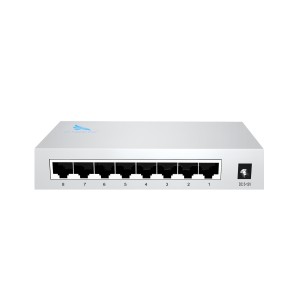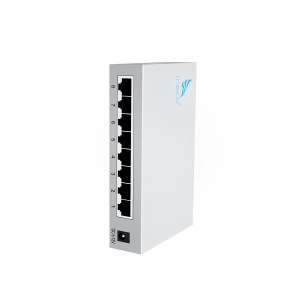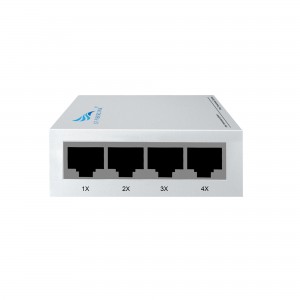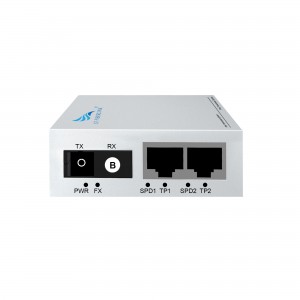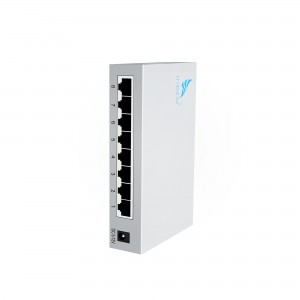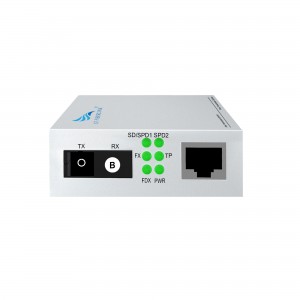2-port 10/100M WDM Media Converter (multi-mode Dual-fiber SC)
2-port 10/100M WDM Media Converter (multi-mode Dual-fiber SC)
Product Features:
The general manager of Huizhou Feiguang Technology Co., Ltd. introduced the revolutionary optoelectronic multi-mode dual-fiber transceiver
Are you tired of dealing with complex wiring systems and bulky equipment to convert optical signals to electrical signals? Don’t hesitate any longer, Huizhou Feiguang Mayor Technology Co., Ltd. has launched its latest innovation – optoelectronic multi-mode dual-fiber transceiver. This cutting-edge device combines the functions of a transceiver and an optical-to-electrical converter to provide a simplified and efficient solution for your communication needs.
At Huizhou Feiguang Technology Co., Ltd., we are committed to providing high-quality and innovative products to meet the ever-changing needs of the market. With our rich experience in 5G communication equipment, 10G core switches, industrial cloud network managed switches and fiber optic transceivers, we design optoelectronic multimode dual fiber transceivers to meet the growing demands of modern communication infrastructure.
Optical multimode dual fiber transceivers are designed for maximum flexibility and ease of use. The device has a 4-digit dial that allows you to easily configure and customize its settings according to your specific requirements. With a simple turn of a knob, you can seamlessly tune the transceiver for optimal performance in your network setup.
The photoelectric multi-mode dual-fiber transceiver is equipped with SC interface to ensure safe and reliable connection. The interface is broadly compatible with a variety of fiber optic systems, making it ideal for a variety of applications including data centers, telecom networks, and enterprise environments. Say goodbye to compatibility issues and experience seamless connectivity with our advanced transceiver solutions.
For easy monitoring and troubleshooting, our optoelectronic multimode dual fiber transceivers feature dynamic LED indicators. The indicator provides real-time status updates, enabling you to quickly identify any potential issues and take appropriate action. With this intuitive visual feedback system, managing your network becomes more convenient and efficient.
Huizhou Feishichang Photoelectric Technology Co., Ltd. takes pride in providing high-quality, humanized products. Optical multimode dual-fiber transceivers are no exception. Designed with simplicity in mind, the device is extremely easy to use even for those with limited technical expertise. With minimal installation and configuration requirements, you can have your network up and running in no time.
To sum up, the photoelectric multi-mode dual-fiber transceiver of Huizhou Feishichang Optoelectronics Technology Co., Ltd. provides a revolutionary solution for your communication needs. The device’s multifunctional features, such as transceiver and optical-to-electrical converter functions, simplify your network setup while ensuring reliable connections. Its user-friendly features, such as a 4-digit dial and dynamic LED indicators, make it extremely easy to use and monitor. Experience the future of communications technology with an optoelectronic multimode dual-fiber transceiver.
What This Product Does
◇ The CF-102MN-2 is a media converter designed to convert 100BASE-FX fiber to 100Base-TX copper media or vice versa. Designed under IEEE 802.3u 10/100Base-TX and 100Base-FX standards, the CF-102MN-2 is designed for use with multi-mode fiber cable utilizing the SC-Type connector. The CF-102MN-2 supports longwave (LX) laser specification at a full wire speed forwarding rate. It works at 1310nm on both transmitting and receiving data.
◇ Other features of this module include the ability to be used as a stand alone device (no chassis required), Auto MDI/MDI-X for TX port, Auto negotiation of duplex mode. The CF-102MN-2 will transmit at extended fiber optic distances utilizing multi-mode fiber up to 2 kilometers.
Other Features
◇ Besides, this media converter can be used as a standalone device (no rack required) or used with CF FIBERLINK’s CF-2U14 rack for auto MDI/MDI-X in TX port in which duplex mode is automatically negotiated.
technical parameter:
| Model | CF-102MN-2 | |
| Interface Characteristics | ||
| Fixed Port | 1* 10/ 100Base-TX RJ45 port1* 155M uplink SC fiber port | |
| Ethernet Port | 10/ 100Base-TX auto-sensing, full/half duplex MDI/MDI-X self-adaption | |
| Twisted PairTransmission | 10BASE-T: Cat3,4,5 UTP(≤100 meter)100BASE-T: Cat5e or later UTP(≤100 meter) | |
| Optical Port | The default optical module is multimode dual fiber 2km, SC port | |
| Wavelength/Distance | multimode: 850nm 0~550M,1310nm 0~2KM | |
| Chip Parameter | ||
| Network Protocol | IEEE802.3 10BASE-T, IEEE802.3i 10Base-T,IEEE802.3u 100Base-TX, IEEE802.3u 100Base-FX, IEEE802.3x | |
| Forwarding Mode | Store and Forward(Full Wire Speed) | |
| Switching Capacity | 0.4Gbps | |
| Buffer Memory | 0.3Mpps | |
| MAC | 1K | |
| LED Indicator | Fiber | FX(green) |
| rate | SD/SPD1 (green)SPD2: 10/ 100 (green) | |
| Data | TP (green) | |
| Single / duplex | FDX (green) | |
| Power | PWR (green) | |
| Power | ||
| Working Voltage | AC:100-240V | |
| Power Consumption | Standby<1W, Full load<3W | |
| Power Supply | DC:5V/2A industrial power supply | |
| Lightning protection &Certification | ||
| Lightning protection | Lightning protection: 4KV 8/20us, Protection level: IP30 | |
| Certification | CCC;CE mark, commercial; CE/LVD EN60950;FCC Part 15 Class B; RoHS | |
| Physical Parameter | ||
| Operation TEMP | -20~+55°C;5%~90% RH Non condensing | |
| Storage TEMP | -40~+85°C;5%~95% RH Non condensing | |
| Dimension (L*W*H) | 94mm* 71mm*27mm | |
| Installation | Desktop, CF-2U14 slot rack | |
Product Size:

How to choose a fiber optic transceiver?
Optical fiber transceivers break the 100-meter limitation of Ethernet cables in data transmission. Relying on high-performance switching chips and large-capacity caches, while truly achieving non-blocking transmission and switching performance, they also provide balanced traffic, isolation and conflict. Error detection and other functions ensure high security and stability during data transmission. Therefore, fiber optic transceiver products will still be an indispensable part of actual network construction for a long time. So, how should we choose fiber optic transceivers?
1. Port function test
Mainly test whether each port can work normally in the duplex state of 10Mbps, 100Mbps and half-duplex state. At the same time, it should be tested whether each port can automatically select the highest transmission speed and automatically match the transmission rate of other devices. This test can be included in other tests.
2. Compatibility test
It mainly tests the connection ability between the optical fiber transceiver and other devices compatible with Ethernet and Fast Ethernet (including network card, HUB, Switch, optical network card, and optical switch). The requirement must be able to support the connection of compatible products.
3. Cable connection characteristics
Test the fiber optic transceiver’s ability to support network cables. First, test the connection ability of Category 5 network cables with lengths of 100m and 10m, and test the connection ability of long Category 5 network cables (120m) of different brands. During the test, the optical port of the transceiver is required to have a connection capability of 10Mbps and a rate of 100Mbps, and the highest must be able to connect to a full-duplex 100Mbps without transmission errors. Category 3 twisted pair cables may not be tested. Subtests can be included in other tests.
4. Transmission characteristics (transmission loss rate of data packets of different lengths, transmission speed)
It mainly tests the packet loss rate when the optical fiber transceiver optical port transmits different data packets, and the connection speed under different connection rates. For the packet loss rate, you can use the test software provided by the network card to test the packet loss rate when the packet size is 64, 512, 1518, 128 (optional) and 1000 (optional) bytes under different connection rates. , the number of packet errors, the number of packets sent and received must be more than 2,000,000. Test transmission speed can use perform3, ping and other software.
5. The compatibility of the whole machine to the transmission network protocol
It mainly tests the compatibility of fiber optic transceivers to network protocols, which can be tested in Novell, Windows and other environments. The following low-level network protocols such as TCP/IP, IPX, NETBIOS, DHCP, etc. must be tested, and the protocols that need to be broadcast must be tested. Optical transceivers are required to support these protocols (VLAN, QOS, COS, etc.).
6. Indicator status test
Test whether the status of the indicator light is consistent with the description of the panel and the user manual, and whether it is consistent with the current status of the fiber optic transceiver.









